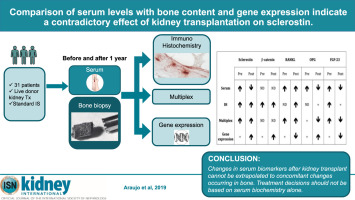Kidney International ( IF 19.6 ) Pub Date : 2019-06-25 , DOI: 10.1016/j.kint.2019.06.007 Maria Júlia Correia Lima Nepomuceno Araújo 1 , Igor Denizarde Bacelar Marques 1 , Fabiana Giorgetti Graciolli 2 , Luzia Fukuhara 2 , Luciene Machado Dos Reis 2 , Melani Custódio 2 , Vanda Jorgetti 2 , Rosilene Mota Elias 3 , Elias David-Neto 4 , Rosa M A Moysés 3

|
In an attempt to clarify the mechanisms of post-transplant bone disease we investigated the bone content and gene expression of several bone-related proteins. After a successful kidney transplant, the content of sclerostin in bone biopsies was found to be increased as measured by immunohistochemistry, multiplex assay, and gene expression despite a concomitant decrease of sclerostin in the serum. The phosphorylation of beta-catenin was increased, confirming Wnt pathway inhibition, an effect accompanied by an increase of the receptor activator of nuclear factor kappa-Β ligand (RANKL) and a decrease of osteoprotegerin protein levels in both serum and bone. Thus, changes in circulating biomarkers after kidney transplantation cannot be easily extrapolated to concomitant changes occurring in the bone. Hence, overall treatment decisions post kidney transplant should not be based on serum biochemistry alone.
中文翻译:

血清水平与骨含量和基因表达的比较表明肾移植对硬化素的作用是矛盾的。
为了弄清楚移植后骨病的机制,我们研究了几种骨相关蛋白的骨含量和基因表达。成功进行肾脏移植后,尽管血清中硬化素减少,但通过免疫组织化学,多重分析和基因表达检测发现,骨活检中硬化素的含量增加了。β-catenin的磷酸化增加,证实了Wnt途径的抑制,这种作用伴随着核因子kappa-Β配体(RANKL)受体激活剂的增加以及血清和骨骼中骨保护素蛋白水平的降低。因此,肾脏移植后循环生物标志物的变化不能轻易地推断为伴随骨骼发生的变化。因此,



























 京公网安备 11010802027423号
京公网安备 11010802027423号